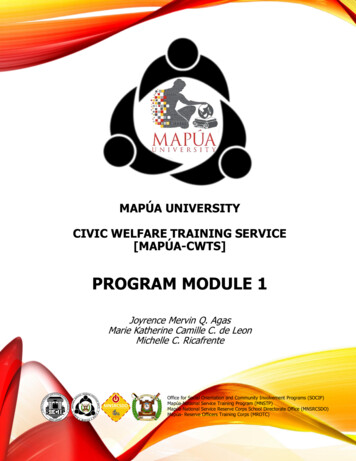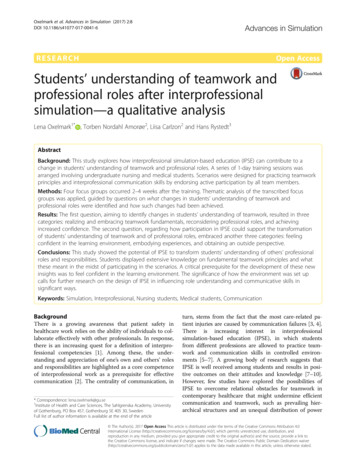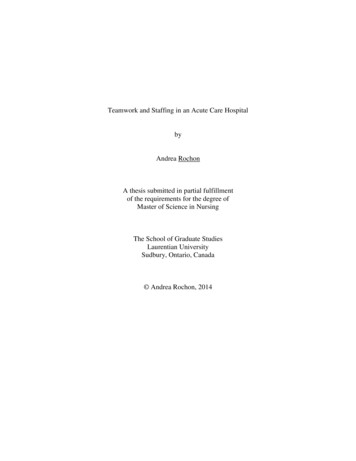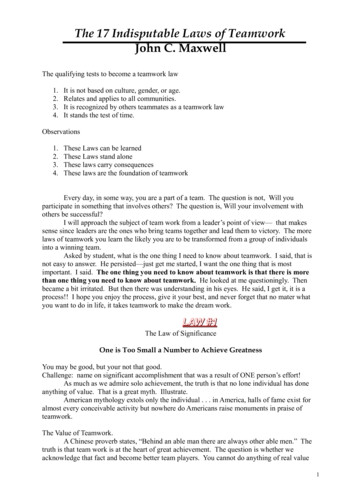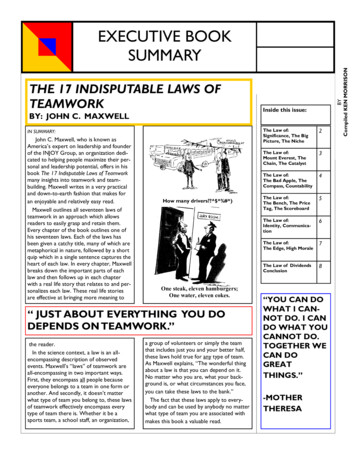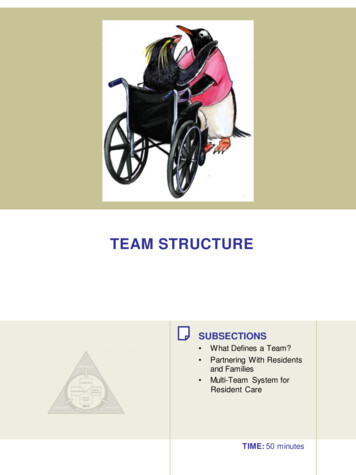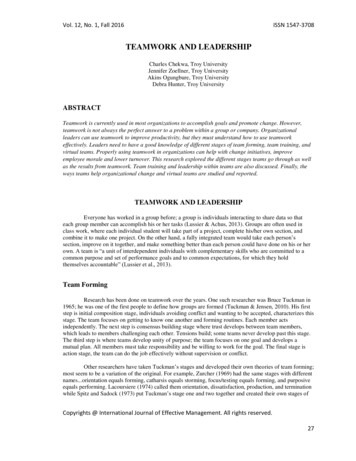
Transcription
Vol. 12, No. 1, Fall 2016ISSN 1547-3708TEAMWORK AND LEADERSHIPCharles Chekwa, Troy UniversityJennifer Zoellner, Troy UniversityAkins Ogungbure, Troy UniversityDebra Hunter, Troy UniversityABSTRACTTeamwork is currently used in most organizations to accomplish goals and promote change. However,teamwork is not always the perfect answer to a problem within a group or company. Organizationalleaders can use teamwork to improve productivity, but they must understand how to use teamworkeffectively. Leaders need to have a good knowledge of different stages of team forming, team training, andvirtual teams. Properly using teamwork in organizations can help with change initiatives, improveemployee morale and lower turnover. This research explored the different stages teams go through as wellas the results from teamwork. Team training and leadership within teams are also discussed. Finally, theways teams help organizational change and virtual teams are studied and reported.TEAMWORK AND LEADERSHIPEveryone has worked in a group before; a group is individuals interacting to share data so thateach group member can accomplish his or her tasks (Lussier & Achus, 2013). Groups are often used inclass work, where each individual student will take part of a project, complete his/her own section, andcombine it to make one project. On the other hand, a fully integrated team would take each person’ssection, improve on it together, and make something better than each person could have done on his or herown. A team is “a unit of interdependent individuals with complementary skills who are committed to acommon purpose and set of performance goals and to common expectations, for which they holdthemselves accountable” (Lussier et al., 2013).Team FormingResearch has been done on teamwork over the years. One such researcher was Bruce Tuckman in1965; he was one of the first people to define how groups are formed (Tuckman & Jensen, 2010). His firststep is initial composition stage, individuals avoiding conflict and wanting to be accepted, characterizes thisstage. The team focuses on getting to know one another and forming routines. Each member actsindependently. The next step is consensus building stage where trust develops between team members,which leads to members challenging each other. Tensions build; some teams never develop past this stage.The third step is where teams develop unity of purpose; the team focuses on one goal and develops amutual plan. All members must take responsibility and be willing to work for the goal. The final stage isaction stage, the team can do the job effectively without supervision or conflict.Other researchers have taken Tuckman’s stages and developed their own theories of team forming;most seem to be a variation of the original. For example, Zurcher (1969) had the same stages with differentnames.orientation equals forming, catharsis equals storming, focus/testing equals forming, and purposiveequals performing. Lacoursiere (1974) called them orientation, dissatisfaction, production, and terminationwhile Spitz and Sadock (1973) put Tuckman’s stage one and two together and created their own stages ofCopyrights @ International Journal of Effective Management. All rights reserved.27
Vol. 12, No. 1, Fall 2016ISSN 1547-3708team forming (Stage One: anxiety and confusion; Stage Two: trust, cohesiveness and interdependence;Stage Three: anxiety about the end of the team). Braaten (1974) also put forth a model that included aninitial phase lacking in structure; a second phase characterized by conflicts between subgroups; a workphase where norms are agreed upon and trust forms; and the final phase of termination. (Tuckman et al.,2010).Charrier (1972) developed his own stages of teams that he called “Cog’s Ladder”. He theorizedthat teams must move through each stage before going on to another stage; in other words, it is not possibleto skip a stage. His stages are the polite stage, the “why we are here” stage, the bid for power stage, theconstructive stage, and the esprit stage. Much like Tuckman’s first stage, the initial stage involves teammembers avoiding controversy and wanting to be liked. Cliques may form at this stage, which will comeinto play during later stages. The quickest way to get through the initial stage is with nonverbalteambuilding; members will be able to communicate without the “noise” that interferes with verbal andnonverbal communication (Charrier, 1972 p. 31). The second stage normally sets up the objectives andgoals of the group with active participation between the members. During the power struggle stage, thethird stage, conflict arises when each member of the group tries to influence other members to his or herpoint of view. Cliques that formed during stage one will show their power in this stage by supporting onemember in power. Roles are important in this stage; typically, a “harmonizer/compromiser” member willstep forward as well as a “gatekeeper” (Charrier, 1972 p. 33). These members will try to get the group tomove past stage three into stage four, which is the reasonable constructive stage. Team members becomemore open minded and realize that other members have the right to different values. The attitude in thegroup will change, especially with exercises in sharing, helping and listening to help the team move to thelast stage. The final stage is collegial; many teams never reach this stage. The team is incredibly cohesiveand unified. The group is intensely loyal to each other and able to put aside personal differences. They maywant a symbol to show their pride of the team. The greater the accomplishment in stage four, the greater theesprit will be in stage five. Members must be willing to be vulnerable and risk being wrong. Charrier(1972) states that it is possible for teams to slide backward into a previous stage (usually with the additionof another member) but it is also possible to build back up into esprit.TEAMWORK RESULTSResearch has shown that using teams in organizations can increase productivity and employeemorale (Delarue, Hootegem, Procter, & Burride, 2008). Their study examined three hypotheses: teamworkis positively linked to organizational outcomes; this link can be explained by the impact of the team onemployee attitudes; and organizational and environmental factors will play a role as well. Their researchsupports other studies and arrive at the same conclusion that performance is positively related to teamwork(Delarue et al., 2008). In addition, teamwork also increases an organization’s competitiveness financially.Finally, employee attitudes (such as commitment and motivation) and behavior (such as absenteeism andturnover) are impacted positively by teamwork (Delarue et al., 2008). Teamwork can make employees feelempowered by solving problems as soon as they occur rather than consulting with a manager; in thismanner, teamwork can simplify the organizational structure of a business and reduce the number ofsupervisors. These group dynamics can also motivate employees by making them all work toward acommon goal. Staggers, Garcia, & Nagelhout (2008) also found that teamwork can promote brainstormingwhich increases productivity; additionally, teamwork can take the different perspectives that each employeeshould help solve problems in an efficient manner.Team TrainingUsing teamwork to strategically reach goals in today’s organizations means that managers must bewilling to put the time into training teams. Rentsch, Heffner, and Duffy (1994) posit that each teammember will rely on their own experience with teamwork as their “schema” and must be able to drop theirpast in order to work effectively with the team. Different members will bring different experience levelsCopyrights @ International Journal of Effective Management. All rights reserved.28
Vol. 12, No. 1, Fall 2016ISSN 1547-3708with them to the team; managers must be aware of this and encourage members to share their experiences.For example, there are several stages of gaining knowledge: declarative (facts and rules), compilation (therelationship between the facts), and procedural (skill is innate). Team members who are at the proceduralstage of knowledge will not relate as well to members at the declarative stage. Additionally, members withhigher experience will show a better performance while those with lower experience will show more stress.Team training should be focused on the experience of the group to avoid miscommunication betweenmembers. Managers must be ready to help the team set goals, communicate, and use their skills (Rentsch etal., 1994). Staggers et al. (2008) also believed that team building is necessary. “We believe firmly that themost successful teamwork occurs after team building” (p.474). Teamwork should improve communication,especially as team members move through the team building process. Teamwork can be learned, but itrequires instructions in team building as well as support (Staggers et al., 2008).Teamwork and LeadershipLeadership can be a very important component in teamwork. Teams can either thrive or fail basedon leadership; however, sometimes even the best leader cannot make the difference in a poor team(Sohmen, 2013). Effective leaders will try to promote the team’s problem-solving skills while giving themthe best opportunities. Sohmen (2013) states that leaders influence and motivate teams; they do not coerce;they achieve results by developing a shared vision and communicating it to the team whilst influencingwith passion (p. 4). Therefore, the first step for an effective leader is to develop the vision and objectivesfor the team. He or she will establish each team member’s roles and responsibilities while promotingindependence. The leader should understand the culture of the team and attempt to strengthen the team withmutual encouragement and trust. Successful leaders also provide constructive feedback that focuses onspecific behaviors (rather than a person) to build positive relationships and team unity. Sohmen (2013)found eight factors of the most productive leaders; they are: vision, integrity, communication,collaboration, creativity, goal orientation, empowerment, and team building (esprit). He reminds us that “ittakes an effective communicator with charisma to motivate, mentor, inspire, and build a cohesive team,while being aware of the individuality and unique aspirations of each team member” (p. 10).Nurmi (1996) states that there are four different styles of leadership in teams. The first type isdictatorial; this is a situation whereby the leader is in complete control and does not promote teamwork atall since s/he is the “dictator”. This style of leadership can lead to teamwork “camouflaging” problems inautocratic organizations. The next style is compromising; the team will compromise on an average solutioninstead of the best solution. This leader is trying to please everyone and thinks that consensus in the groupis more important than the team output. Integrative is the third style; every team member gains learning inthis style; the team takes everyone’s resources to blend them together. Integrative leaders must be activelisteners who accept different views. They must take the time to get all the team’s resources out in the openand integrate them into one unit. The only problem in integrative teams is the possibility of groupthink,which is when the group cannot accept criticism or any other viewpoints (Nurmi, 1996). The final style issynergistic, which means the team creates something more than any one member had before. Nurmi arguesthat this type of teamwork is not usually from intentional management but comes about spontaneously withthe right group of people. Synergistic teams are innovative, with high enthusiasm, motivation, andcommitment. They have been observed in many artistic teams, such as string quartets. Poor teamworkapplication will waste time and lead to lower morale when it doesn’t produce anything (Nurmi, 1996).Leaders also should fulfill a “coach” role in teamwork (Rosner, 2001). In his interview withMarshall Goldsmith (one of the top five executive coaches in the world), Rosner asks about the best way tocoach teams. Goldsmith states three things should happen in coaching teams: ask the leader if she can let goof the past, be honest with feedback, and be supportive. The individual must be committed to his/her teamand not focus on any past events. In addition, honest feedback is essential in leadership in general andespecially in teamwork. Finally, the leader can say, “You are a successful person. My job is to help youfurther achieve your goals and objectives. But in order for you to do that, there are certain things you mustdo" (Rosner, 2001, p. 62).Copyrights @ International Journal of Effective Management. All rights reserved.29
Vol. 12, No. 1, Fall 2016ISSN 1547-3708Teamwork and ChangeLeaders often must be a change agent through teamwork; however, Drew & Coulson-Thomas(1997) found that the benefits of teamwork during a change initiative are often exaggerated while thedifficulties are underestimated. The proper team can promote change, but the organization needs toconsider the tasks to be undertaken as well as possible barriers. Drew et al. (1997) list several “changeroadblocks”, such as lack of sufficient senior management support and commitment; lack of clear vision,goals and objectives; inadequate training and skills development; unwillingness to allow teams necessaryautonomy and decision-making powers; lack of team spirit; executive impatience and push for short-termresults. They suggest several solutions. Leaders should encourage teams to have honest communication andanalysis during the learning process. They should also adopt multiple views, such as looking at problemsfrom several perspectives (different cultures, parts of the world, etc.). Knowledge needs to be exchangedfreely for the benefit of all, with innovative learning techniques and new technology. Finally, executivesand board members need to be involved in the teamwork process; and effective teamwork must begin at thetop (Drew et al., 1997, p. 166).Virtual TeamworkGlobal organizations may face an entirely new model in teamwork - virtual teamwork. With thetechnology of today’s world, team members do not even have to be on the same continent to work as ateam. A study from Intel Corporation revealed that almost two-thirds of its employees are involved inteams that are located at different sites (Nunamaker, Reinig, & Briggs, 2009). However, there are severalissues with this type of teamwork. Virtual team members may struggle with establishing relationships withtheir teammates; they also face problems with keeping their focus on their team and not on their workplaceas well as having to incorporate the team into their daily routine.Nunamaker et al. (2009) have several principles to help leaders with virtual teamwork barriers.The first principle is for leaders to adjust reward structures; it is easy to lose virtual team members throughthe old saying “out of sight, out of mind”. Therefore, leaders need to make the rewards with virtual workthe same as for onsite work. Focus is another problem; with no face-to-face meetings, it becomes difficultto control focus on the work at hand. Technology is extremely helpful with this barrier. Team leaders cancontrol what appears on each employee’s screen with shared windows. Application sharing promotessharing instantly, so that no effort is wasted in attempting to figure out what is said in an email ordocument. Virtual teams should have a “virtual presence” (p. 115); if team members are working togetherat the same time, their computers can display a list that has the active participants, or an audible cue when ateam members joins in or leaves a session. If team members are working during different times (especiallywith global work during different time zones), it may be helpful to have each team member send an emailor text to the others every time they add to the team effort. Global work also means that standards andterminology must be agreed upon; for example, members using the metric system need to make sure theentire team is using the metric system as well.Another barrier to virtual teamwork can appear if the technology needed causes extra work for themembers. For example, if team members must work late to collaborate or go to a separate room for videoconference, they will often feel as if it is extra work and not worthwhile (Nunamaker et al., 2009). Teammembers should be able to use the same technology with their virtual teammates as they do with their localworkmates, such as cameras, messaging, discussion and voting tools. Virtual work should be an instanceof a person’s regular work, not a separate, disjoint activity (Nunamaker et al., 2009, p. 116).The final principles involve communication. Team building activities that build familiarity withinthe team should start immediately upon formation. When the team knows each other and trusts each other,it makes teamwork that much better. Team members need to be very explicit in their communication; withCopyrights @ International Journal of Effective Management. All rights reserved.30
Vol. 12, No. 1, Fall 2016ISSN 1547-3708no nonverbal cues to follow, it is easy to misinterpret an email or message, so members must be very clear.Additionally, member should use anonymity when appropriate as it can encourage honest communication.Research has shown that anonymous discussions tend to elicit more critical analysis of the topic underconsideration, and reduce politically based decision making (Nunamaker et al., 2009, p. 115). Finally, thegroup must be able to self-facilitate independently.CONCLUSIONTeamwork has been shown to improve productivity as well as increase employee morale.However, teamwork is not always appropriate. This paper explored types of team forming, results fromteamwork, team training, leadership within teams, how teamwork can affect change, and virtual teams.One of the best ways to improve teamwork is to follow four simple rules about ourselves (Ruiz,1997). “Be impeccable with your word. Don’t take anything personally. Don’t make assumptions. Alwaysdo your best.” If everyone on a team including the leader would follow these agreements, teams can easilywork together to accomplish each goal they set.REFERENCESBraaten, LJ. (1974). Developmental phases of encounter groups and related intensive groups: Acritical review of models and a new proposal. Interpersonal Development, 5, 112-129.Charrier, G. O. (1972). Cog’s Ladder: A model of group growth. SAM AdvancedManagement Journal (00360805), 37(1), 30.Delarue, A., Van Hootegem, G., Procter, S., & Burridge, M. (2008). Teamworking andorganizational performance: A review of survey-based research. International Journal ofManagement Reviews, 10(2), 127-148.Drew, S., & Coulson-Thomas, C. (1997). Transformation through teamwork: The path to thenew organization? Team Performance Management, 3(3), 162.Lacoursiere, R. (1974). A group method to facilitate learning during the stages of a psychiatricaffiliation. International Journal of Group Psychotherapy, 24, 342-351.Lussier, R.N. & Achus, C.F. (2013). Leadership: Theory, Application, & Skill Development. (5thed.). Mason, OH: South-Western, Cengage Learning.Nunamaker Jr. J, Reinig B, & Briggs R. (2009) Principles for Effective Virtual Teamwork.Communications of the ACM, 52(4), 113-117.Nurmi, R. (1996). Teamwork and team leadership. Team Performance Management, 2(1), 9-13.Rentsch, J. R., Heffner, T. S., & Duffy, L. T. (1994). What you know is what you get fromexperience: Team experience related to teamwork schemas. Group & OrganizationManagement, 19(4), 450-474.Copyrights @ International Journal of Effective Management. All rights reserved.31
Vol. 12, No. 1, Fall 2016ISSN 1547-3708Rosner, B. (2001). 'Team Players' Expect Real Choices. Workforce, 80(5), 62.Ruiz, D.M. (1997). The Four Agreements. San Francisco, CA: Amber-Allen Publishing.Sohmen, V. S. (2013). Leadership and teamwork: Two sides of the same coin. Journal ofInformation Technology and Economic Development, 4(2), 1-18.Spitz, H., & Sadock, B. (1973). Psychiatric training of graduate nursing students. N. Y State Journal ofMedicine, 1, 1334-1338.Staggers, J., Garcia, S., & Nagelhout, E. (2008). Teamwork through team building: face-to-faceto online. Business Communication Quarterly, 71(4), 472-487.Tuckman, B. W., & Jensen, M. A. C. (2010). Stages of small-group development Revisited.Group Facilitation, (10), 43-48.Zürcher, :. (1969). Stages of development in poverty program neighborhood action committees.The Journal of Applied Behavioral Science, 1969, 5(2), 223-258.Copyrights @ International Journal of Effective Management. All rights reserved.32
Teamwork and Leadership Leadership can be a very important component in teamwork. Teams can either thrive or fail based on leadership; however, sometimes even the best leader cannot make the difference in a poor team (Sohmen, 2013). Effective leaders will try to promote the team's problem-solving skills while giving them the best opportunities.
